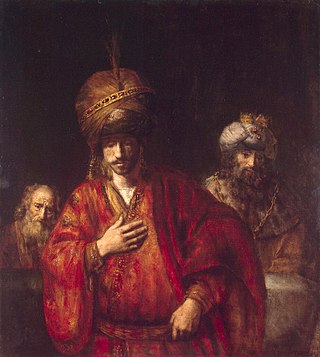Top Qs
Timeline
Chat
Perspective
David and Uriah
1665–1669 painting by Rembrandt van Rijn From Wikipedia, the free encyclopedia
Remove ads
David and Uriah is a late, oil-on-canvas painting by Rembrandt, dated to around 1665 by the Hermitage Museum (which owns it[1]) or c. 1666–1669 in the 2015 Late Rembrandt exhibition at the Rijksmuseum. It shows the moment when David sends Uriah the Hittite to the frontline of the war with the Ammonites so that David can sleep with Uriah's wife Bathsheba.[2] Uriah is identified as the foreground figure, with David and Nathan in the background. It was first given this title by Abraham Bredius in his catalogue of Rembrandt's work – this has been supported by several other scholars from 1950 onwards, including in a 1965 study by Madlyn Kahr.[3]
You can help expand this article with text translated from the corresponding article in Dutch. (January 2023) Click [show] for important translation instructions.
|
The work has also been identified as Haman Recognises His Fate after Haman from the Book of Esther. It entered the Russian imperial collection in 1773 with that title, which the Hermitage still retains.[4][5]
Remove ads
Gallery
- Nathan
- Uriah
- David
See also
References
Wikiwand - on
Seamless Wikipedia browsing. On steroids.
Remove ads




